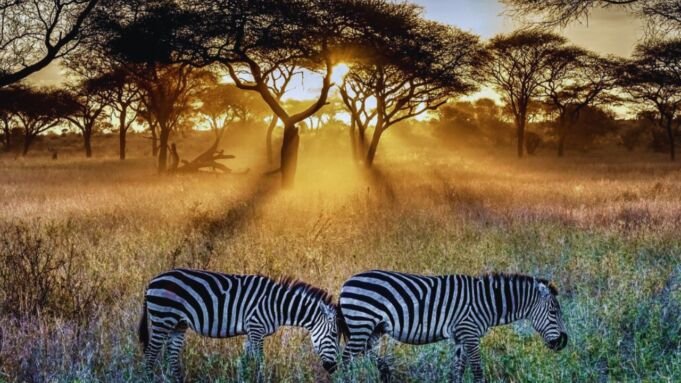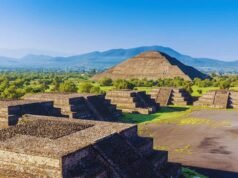Serengeti National Park, located in Tanzania, is a world-renowned wilderness area and a UNESCO World Heritage Site. It is famous for its vast savannahs, diverse wildlife, and the breathtaking annual migration of wildebeest.
This post aims to provide an informative guide to this iconic national park, covering its history, geography, wildlife, and conservation efforts.
The History of Serengeti National Park
The Serengeti was officially designated as a national park in 1951, but its story began much earlier. The area was the homeland of the Maasai people who grazed their cattle on the vast plains. With the rise of safari and trophy hunting in the early 20th century, the need for conservation became apparent, leading to the park’s establishment. Over the decades, the park has been a global leader in wildlife research, significantly contributing to the understanding of various species and their habitats.
The Serengeti is perhaps best known for its role in hosting the Great Migration, an annual event where over 1.5 million wildebeest, along with hundreds of thousands of zebra and gazelle, migrate circularly across the ecosystems in search of fresh pasture. This spectacle is considered one of the ten natural travel wonders of the world. The park is also home to the famed Big Five: elephants, lions, leopards, buffalo, and the rare black rhinoceros, making it one of the best places on earth to witness wildlife.
What is the Geography of Serengeti National Park?
Serengeti is characterized by vast open plains, acacia woodlands, and riverine forests. The park is part of the larger Serengeti ecosystem, which includes the Ngorongoro Conservation Area, Maswa Game Reserve, and other protected areas. The landscape is dotted with rocky outcrops known as kopjes, which provide shelter and vantage points for wildlife.
How can Visitors Experience Serengeti National Park?
Visitors to Serengeti National Park can enjoy a variety of experiences that highlight its natural beauty and rich biodiversity. Here are some of the key activities and tips for making the most of a visit to this iconic park:
Game Drives
Game drives are the most popular way to experience the Serengeti. Guided tours are available at dawn, during the day, and at dusk, which is the best time to see animals in their most active states. These drives offer opportunities to see the Big Five (lion, leopard, rhinoceros, elephant, and Cape buffalo) and witness the Great Migration, depending on the season.
Hot Air Balloon Safaris
For a breathtaking view of the park from above, visitors can book a hot air balloon safari. This experience provides a unique perspective of the vast landscape and wildlife, especially at sunrise. It’s a peaceful way to grasp the scale of the migration and the diversity of the Serengeti’s ecosystems.
Walking Safaris
For those who want a more immersive experience, walking safaris led by experienced guides offer a closer connection to the environment. These walks allow visitors to learn about the smaller flora and fauna, track animals on foot, and understand the ecological details that make the Serengeti so special.
Cultural Tours
Visiting nearby Maasai villages can enrich the safari experience. These tours offer insights into the local Maasai culture, traditions, and their symbiotic relationship with the land and wildlife. It’s a chance to see their traditional dances, crafts, and way of life.
Photographic Tours
Photography enthusiasts can join specialized tours designed to find the best spots and times of day for capturing the stunning scenery and wildlife of the Serengeti. These tours are often led by professional photographers who provide tips and guidance on capturing the perfect shot.
Camping and Lodging
There are various accommodation options within and around the Serengeti, ranging from luxury lodges to mobile campsites. Staying inside the park allows visitors to hear the sounds of nocturnal animals and experience the wilderness around the clock.
Best Times to Visit
The Serengeti is a year-round destination, but the best wildlife viewing times are during the dry season from June to October when animals congregate around water sources. The wildebeest migration usually reaches the Serengeti between July and August, and the calving season is from late January to February.
Masai Mara National Reserve
The Masai Mara National Reserve is renowned for its spectacular natural beauty and rich tapestry of biodiversity. Often simply referred to as “the Mara,” the reserve serves as the northern continuation of the Serengeti National Park in Tanzania. It’s a critical component of the annual Great Migration, where millions of wildebeest, zebra, and gazelle traverse its plains in search of fresh pasture.
The landscape is punctuated by acacia trees and threaded by meandering rivers that draw a vast array of wildlife, making the Mara a wildlife enthusiast’s paradise. With its open grasslands, rolling hills, and iconic Maasai warriors grazing their livestock alongside wild animals, the Masai Mara offers an almost mythical experience of the African wilderness. Visitors to the reserve can enjoy game drives, walking safaris, and hot air balloon flights that offer an unparalleled view of the sprawling savannah below.
What is Serengeti National Park Famous For?
Serengeti National Park is famed worldwide for its stunning landscapes and extraordinary wildlife. It is perhaps most renowned for hosting the Great Migration, a remarkable natural phenomenon where over a million wildebeest, accompanied by hundreds of thousands of zebras and gazelles, traverse the plains in search of fresh pasture. This annual event is considered one of the greatest wildlife spectacles on earth.
Additionally, the park is home to the iconic Big Five—lions, leopards, elephants, buffalo, and rhinoceros—drawing nature enthusiasts and photographers from across the globe. The diverse habitats within the Serengeti, ranging from grassy plains to riverine forests, support a vast array of other wildlife, making it a central point for biodiversity and conservation in East Africa.
What Wildlife Can Be Found in Serengeti National Park?
Serengeti is home to a remarkable diversity of wildlife, including the iconic Big Five (lion, elephant, buffalo, leopard, and rhinoceros) as well as cheetahs, giraffes, zebras, and various antelope species. The park is also renowned for the annual migration of over a million wildebeest and hundreds of thousands of zebras, a spectacle that has been described as one of the greatest wildlife shows on earth.
Conclusion
Serengeti National Park offers a unique opportunity to witness the wonders of the natural world in a pristine and diverse ecosystem. Whether it’s the awe-inspiring wildlife, the sweeping landscapes, or the conservation efforts, the park continues to captivate visitors from around the globe. By understanding the history, geography, wildlife, and conservation efforts of Serengeti National Park, one can gain a deeper appreciation for this remarkable natural treasure.
















[…] Snorkeling & Diving in Silfra: Experience the surreal underwater world between the Eurasian and North American tectonic plates in Thingvellir National Park. […]
Comments are closed.